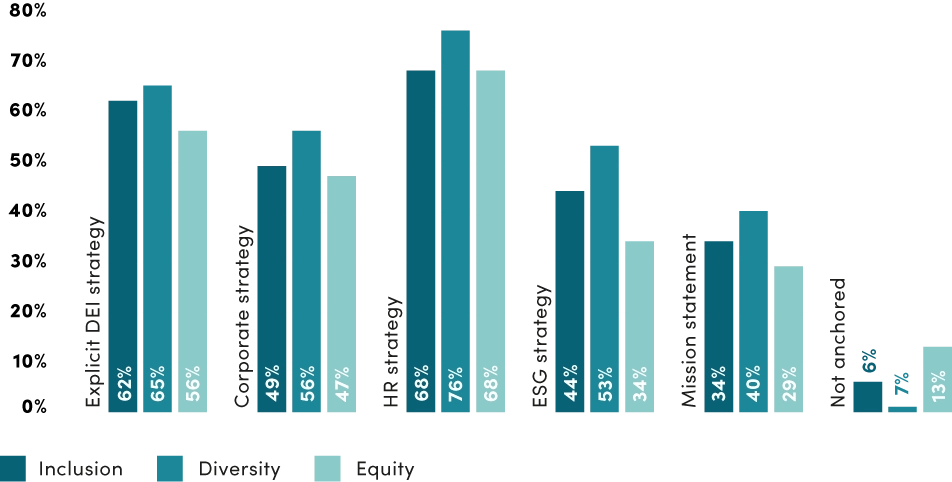Approximately half of the companies in the sample anchor inclusion and diversity in their corporate strategies. Slightly below half also includes equity. Inclusion has increasingly been recognized as a success driver for productivity, innovation, and retention. Consequently, the percentage of companies that anchor inclusion in their HR strategy has increased by 12 percentage points. Yet overall, companies are still more likely to prioritize diversity over inclusion. This indicates that companies have not yet fully internalized the fact that the benefits of diversity cannot be reaped without inclusion.

However, as a regression analysis shows, companies with equity anchored in their mission statement show a lower attrition rate than companies without. This means that embedding such value not only promotes inclusion but also strengthens employee retention, and contributes to a more loyal and committed workforce.
In addition to what is outlined in a business strategy or in an organization’s mission statement, it is the workplace culture that significantly impacts employees’ engagement, productivity, and loyalty. Our Workplace Culture Survey reveals that employees who do not feel included, do not perceive themselves as having fair, transparent, and attractive development opportunities, do not feel respected and valued by their supervisor, and who experienced or observed discrimination are significantly more likely to consider leaving their employer for another one more committed to DEI. Individuals who feel excluded or marginalized are more likely to experience negative health outcomes, which in turn influences turnover intentions (Ehrhart & Chung, 2023). An inclusive work environment helps employees build resilience, making them more likely to adapt to their roles and reducing their turnover rates (Davies et al., 2019). Furthermore, inclusive leadership plays a key role in reducing turnover by fostering positive leader-member relationships, which help mitigate the negative effects of diversity on turnover intentions (Nishii & Mayer, 2009).
A lack of psychological safety and belonging undermines engagement, creativity, and collaboration, which are essential for both individual satisfaction and organizational performance (Reiter-Palmon & Millier, 2023). In contrast, an inclusive environment where employees feel respected, valued, and fairly treated reinforces a sense of authenticity, strengthens interpersonal trust, and fosters long-term commitment to the organization.
I would consider leaving my current organization and moving to another that is more committed to DEI.
A recent study conducted by Bain & Company in collaboration with Advance analyzed why women leave tech jobs at alarming rates: The study found that every second woman is considering changing their employer or leaving the industry altogether. As the main reason, the authors identify a non-inclusive workplace culture. Women often feel isolated, lack a sense of belonging, and support.
27% of the survey respondents agree or strongly agree that they would consider leaving their current organization and moving to another that is more committed to DEI. Assuming there are additional reasons to change one’s employer, let’s deduct a general turnover rate of 10 percentage points and use 17% for the calculation.
For this year’s report sample, 17% corresponds to 64,000 employees. The cost of replacing an employee usually amounts to the yearly salary of the role. If we multiply the number of change-willing employees with the annual median income of CHF 81,000 in Switzerland (2022), being non-inclusive could cost companies up to 5 billion Swiss Francs.
In addition to driving higher employee turnover, a lack of inclusive culture and processes can significantly hinder a company’s capacity for innovation. When meritocratic principles are not upheld, talented individuals may feel undervalued or overlooked, reducing motivation and engagement (Konrad et al., 2021). This perception can further exacerbate disengagement among high performers, and slowing the development of new ideas. As a consequence, this creates what can be described as an “invisible cost”: the organization may fall behind competitors, struggle to respond effectively to market changes, and miss opportunities for creative solutions.
When individuals feel excluded or perceive inequities in career advancement, they are less able to express their true selves at work and contribute fully (Harkema, 2023). These inclusive dynamics are closely linked to the capacity for innovation: an environment in which employees feel valued and integral to the organization fosters the generation of new ideas and creative contributions. A study by the CCDI shows that an inclusive environment enhances team innovation performance (Dwertmann et al, 2025). Diversity contributes significantly to idea generation, especially when a strong culture of inclusion is present.
By contrast, organizations that thoughtfully combine these principles create an environment that fosters a culture of innovation, enhances problem-solving, and strengthens overall competitiveness, ultimately supporting long-term organizational growth and sustainability.
It takes a joint effort and collaboration between politics, companies, business associations, and forward-thinking leaders to accelerate progress toward inclusive meritocracy based on firm values like equality, common ground, and partnership.
“Unless we fix our systems and truly level the playing field so that everyone has an equal opportunity to succeed, meritocracy will remain a myth.”
Siri Chilazi, Co-Author of “Make Work Fair”